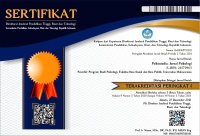Identification of Psychological Factors That Cause And How to Handle Suicide in South Korea Based on Psychological Autopsi
Abstract
The suicide rate in South Korea is high among OECD countries with a total of 4657 suicides in Incheon city and only 1% participating in psychological autopsies. This article focuses on the psychological factors that cause suicide and the government's efforts to prevent suicide. The purpose of this study is to identify based on psychological factors regarding the causes and ways of handling suicides in South Korea seen based on the results of psychological autopsi. This research was conducted using a qualitative approach using the library research method. The results showed that the highest causes of suicide are mental health problems, physical health, financial problems. The most common methods of suicide are hanging and jumping from a height. The South Korean Government's efforts to reduce suicides The Ministry of Health and Welfare established the Korea Psychological Autopsy Center (Korea Foundation for Suicide Prevention) to establish evidence-based suicide prevention policies. The Korea Foundation for Suicide Prevention developed the Korean Psychological Autopsy Checklist (K-PAC), a semi-structured interview tool, by extracting common questions through a review of domestic and foreign literature and selecting items appropriate to the Korean situation. The implications of this study can be a reference for guidelines for other countries to address and prevent the high number of suicides in other countries, especially Indonesia. In addition, South Korea's preventive measures can be a morning focus for mental health survivors in Indonesia
Tingkat bunuh diri di Korea Selatan tergolong tinggi diantara negara OECD yaitu total 4657 orang bunuh diri di kota Incheon dan hanya ada 1% yang berpartisipasi dalam autopsi psikologis. Artikel ini berfokus pada faktor psikologis penyebab terjadinya bunuh diri serta upaya pemerintah dalam mencegah bunuh diri. Tujuan penelitian ini adalah untuk mengidentifikasi berdasarkan faktor psikologis mengenai penyebab dan cara penanganan kasus bunuh diri di Korea Selatan yang dilihat berdasarkan hasil autopsi psikologis. Penelitian ini dilakukan menggunakan pendekatan kualitatif dengan menggunakan metode kajian kepustakaan (library research). Hasil penelitian menunjukkan penyebab paling tinggi bunuh diri yaitu masalah kesehatan mental, kesehatan fisik, masalaah keuangan. Metode bunuh diri yang paling sering dilakukan adalah gantung diri dan lompat dari ketinggian. Upaya Pemerintah Korea Selatan untuk mengurangi kasus bunuh diri Kementerian Kesehatan dan Kesejahteraan mendirikan Pusat Autopsi Psikologi Korea (Korea Foundation for Suicide Prevention) untuk menetapkan kebijakan pencegahan bunuh diri berbasis bukti. Yayasan Korea untuk Pencegahan Bunuh Diri mengembangkan Daftar Periksa Autopsi Psikologi Korea (K-PAC), alat wawancara semi-terstruktur, dengan mengekstrak pertanyaan umum melalui tinjauan literatur domestik dan asing dan memilih item yang sesuai dengan situasi Korea. Implikasi penelitian ini dapat menjadi referensi pedoman bagi negara lain untuk mengatasi dan mencegah tingginya kasus bunuh diri khususnya Indonesia. Selain itu, tindakan preventif yang dilakukan Korea Selatan dapat menjadi fokus pagi para penyintas kesehatan mental di Indonesia.
Keywords
Full Text:
FULL TEXTReferences
Ana, S. Y., & Saefudin, A. (2014). FENOMENA BUNUH DIRI DI KALANGAN PELAJAR KOREA SELATAN. Univeristas Gajah Mada.
Athey, A., Overholser, J., Bagge, C., Dieter, L., Vallender, E., & Stockmeier, C. A. (2018). Risk-taking behaviors and stressors differentially predict suicidal preparation, non-fatal suicide attempts, and suicide deaths. Psychiatry Research, 270, 160–167. https://doi.org/https://doi.org/10.1016/j.psychres.2018.09.032
Bae, M. N., Cho, S. E., Ryu, J. H., Kim, M. H., Jeon, H. J., Shin, E. J., Lee, S. A., Hwang, T. Y., & Kang, S. G. (2022a). Psychiatric and Psychosocial Factors of Suicide Decedents and Survivor of Suicide Loss: Psychological Autopsy Study of Incheon City in South Korea. International Journal of Environmental Research and Public Health, 19(13). https://doi.org/10.3390/ijerph19137895
Bae, M. N., Cho, S. E., Ryu, J. H., Kim, M. H., Jeon, H. J., Shin, E. J., Lee, S. A., Hwang, T. Y., & Kang, S. G. (2022b). Psychiatric and Psychosocial Factors of Suicide Decedents and Survivor of Suicide Loss: Psychological Autopsy Study of Incheon City in South Korea. International Journal of Environmental Research and Public Health, 19(13). https://doi.org/10.3390/ijerph19137895
Brent, D. A., Perper, J. A., Moritz, G., Baugher, M., Schweers, J., & Roth, C. (1994). Suicide in affectively ill adolescents: a case-control study. Journal of Affective Disorders, 31(3), 193–102. https://doi.org/https://doi.org/10.1016/0165-0327(94)90029-9 Get rights and content
Choi, B. Y., & Jeong, H. C. (2015). A Study on the Relationship between Drinking Behavior and Depression of Adult Men Alcohol-dependent Patients. Advanced Science and Technology Letters, 104, 151–155. https://doi.org/10.14257/astl.2015.104.33
Choi, M., Kim, D., & Kim, K. (2015). An Study of Psychological Autopsy of Suicides in Korean Rural Area. Korean Academy of Social Welfare, 67(1), 55–81.
Jordan, J. T., & McNiel, D. E. (2020). Characteristics of persons who die on their first suicide attempt: Results from the National Violent Death Reporting System. Psychological Medicine, 50(8), 1390–1397. https://doi.org/10.1017/S0033291719001375
Kemenkes RI. (2019). Infodatin Pusat Data dan Informasi Kementerian Kesehatan RI. Pusinfokesmas FKM UI.
Kim, B., Jung, K. J., Lee, S. U., Sea, J., Kim, E. Y., Kim, S. H., Jee, S. H., Park, J., Kim, K., & Ahn, Y. M. (2015). The Korea National Suicide Survey ( KNSS ) : Rationale and Design. Korean J. Biol. Psychiatry, 22(1), 1–6.
Korean Statistical Information Service (KOSIS). (2021). Cause of Death Statistics for 2020. https://kosis.kr/
Lee, H., Lee, K., Koo, J.-W., & Park, S.-C. (2015). Suicide in Patients with Schizophrenia : A Review on the Findings of Recent Studies. Korean Journal of Schizophrenia Research, 18(1), 5. https://doi.org/10.16946/kjsr.2015.18.1.5
Milner, A., Sveticic, J., & Leo, D. De. (2013). Suicide in the absence of mental disorder? A review of psychological autopsi studies across countries. International Journal of Social Psychiatry, 59(6), 545–554. https://doi.org/10.1177/0020764012444259
Na, K.-S., Paik, J. W., Yun, M. K., & Kim, H.-S. (2015). Psychological Autopsy: Review and Considerations for Future Directions in Korea. Journal of Korean Neuropsychiatric Association, 54(1), 40. https://doi.org/10.4306/jknpa.2015.54.1.40
Pouliot, L., & Leo, D. De. (2006). Critical Issues in Psychological Autopsy Studies. Suicide and Life-Threatening Behavior, 36(5).
Schmitt, M. T., Postmes, T., Branscombe, N. R., & Garcia, A. (2014). The consequences of perceived discrimination for psychological well-being: A meta-analytic review. Psychological Bulletin, 140(4), 921–948. https://doi.org/10.1037/a0035754
Sea, J., Lee, C., Kim, K., & Kim, S. (2013). Characteristics of Korean Suicide : Korean Social Sciences Review, 3(2), 129–155.
Shneidman, E. S. (2004). Autopsy of a suicidal mind. Oxvord University Press.
Sirin, S. R., Rogers-Sirin, L., Cressen, J., Gupta, T., Ahmed, S. F., & Novoa, A. D. (2015). Discrimination-Related Stress Effects on the Development of Internalizing Symptoms Among Latino Adolescents. Child Development, 86(3), 709–725. https://doi.org/10.1111/cdev.12343
Soleman, S. R., & Utomo, K. (2020). Suicide Prevention: Literature Review (Vol. 8, Issue 4).
Subekti Wulandari, I., Ratnawati, R., & Supriyati, L. (2014). PENGALAMAN PERAWAT INSTALASI GAWAT DARURAT DALAM MERAWAT PASIEN PERCOBAAN BUNUH DIRI DI RUMAH SAKIT Dr. MOEWARDI SURAKARTA. In Jurnal KesMaDaSka-Juli.
Too, L. S., Spittal, M. J., Bugeja, L., Reifels, L., Butterworth, P., & Pirkis, J. (2019). The association between mental disorders and suicide: A systematic review and meta-analysis of record linkage studies. Journal of Affective Disorders, 259, 302–313. https://doi.org/https://doi.org/10.1016/j.jad.2019.08.054
WHO, W. H. O. (2019). Suicide in the world: Global Health Estimates. World Health Organization,Geneva, 32.
Yook, V., Kim, H., Kim, E. J., Kim, Y., Lee, G., Choi, J. H., Shin, M.-H., & Jeon, H. J. (2022). Psychological autopsi study comparing suicide decedents with and without a history of suicide attempts in a nationwide sample of South Korea. Suicide and Life‐Threatening Behavior, 52(2), 190–198.
Zhang, J., Xiao, S., & Zhou, L. (2010). Mental disorders and suicide among young rural Chinese: A case-control psychological autopsi study. American Journal of Psychiatry, 167(7), 773–781. https://doi.org/10.1176/appi.ajp.2010.09101476
DOI: http://dx.doi.org/10.30872/psikostudia.v13i1.13925
Refbacks
- There are currently no refbacks.
Copyright (c) 2024 Hasna Nafila Febianti, Yusti Probowati, & Mary Philia Elisabeth

This work is licensed under a Creative Commons Attribution-ShareAlike 4.0 International License.
Psikostudia: Jurnal Psikologi is indexed by :
PSIKOSTUDIA: Jurnal Psikologi Published by Faculty of Social and Political Siences, University of Mulawarman, Samarinda, East Kalimantan and This work is licensed under a Creative Commons Attribution-ShareAlike 4.0 International License.
_________________________________________
PSIKOSTUDIA: Jurnal Psikologi
Department of Psychology
Faculty of Social and Political Siences, University of Mulawarman
Jl. Muara Muntai Kampus Gn. Kelua Samarinda 75411
Phone: +62 813 35350368
E-Mail: psikostudia@fisip.unmul.ac.id




















